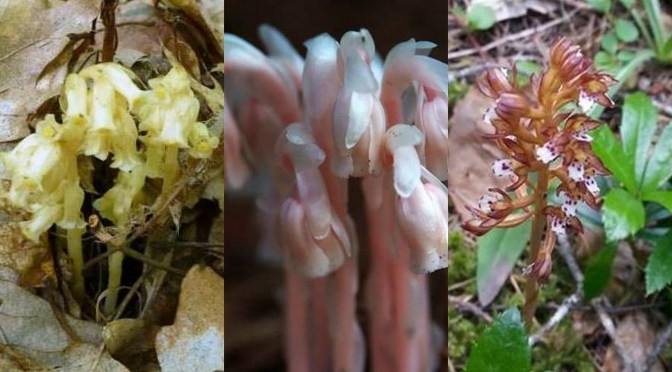Featured images, left to right: pinesap, ghost plant, spotted coralroot orchid. Photos: Katie Grzesiak
Plants are Plants
Plants make their food with energy from the sun; that’s what is often used to define them as plants. If I want to throw my degrees around, I call them “photoautotrophs,” from the Greek for “light,” “self,” and “feed.” Photosynthesis! It’s super neat, honest.
Luckily for this article, that’s not the end of the story. Some plants got tricksy after a while and brought in a sprinkling of vampirism, communism, and Tragedy of the Commons shenanigans, and the result is even cooler than normal plants.
Parasitic Plants are Vampires
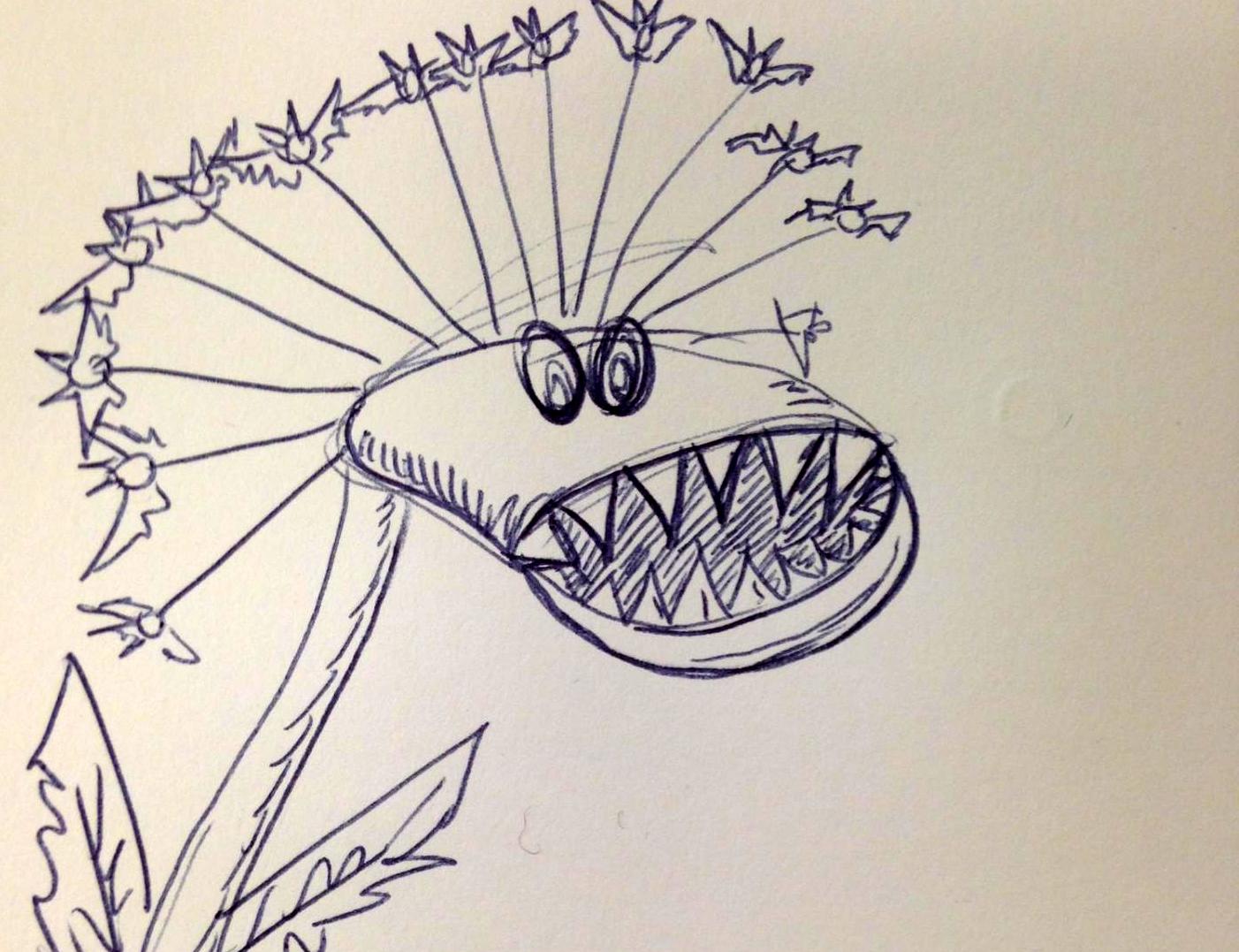
Completely realistic vampire-plant sketch by Laura Garrison. Please appreciate the bat-crown.
Some plants are heterotrophic, like us, and parasitize directly on other plants. One that may spring to mind is the Christmas favorite, mistletoe (Viscum album), which attaches itself to and sucks water and nutrients from branches of trees, but still has chlorophyll to photosynthesize for itself. Plants like clustered broomrape (Orobanche fasciculata) and beechdrops (Epifagus americana) are true parasites; they connect themselves to the roots of other plants with sneaky penetrating roots of their own, then steal all the sugary goodness they need to live. If broomrape was human-y, it would be a vampire, sneaking in and sucking out “blood” from the other plant’s “veins.”
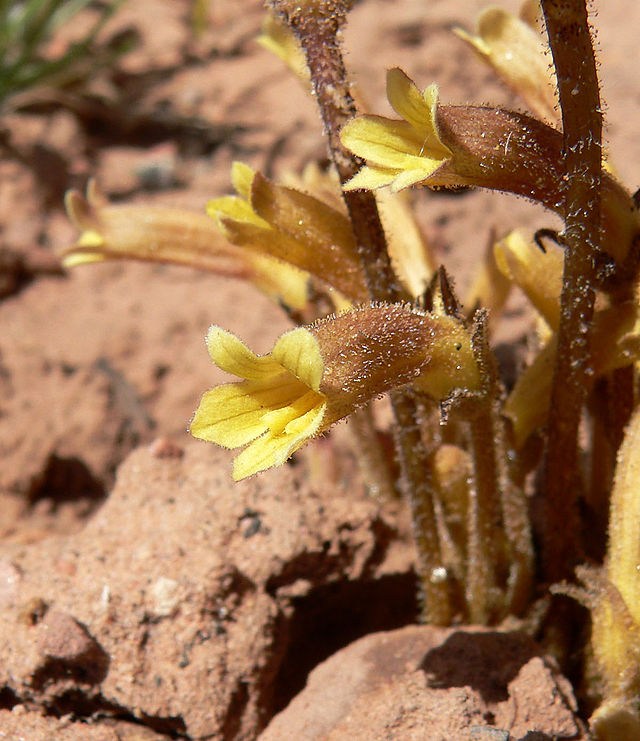
Clustered broomrape flowers, which probably don’t violate sweeping implements. Photo: Stan Shebs
The partnership is often quite specific; beech drops need American beech (Fagus grandifolia), while broomrape’s host (at least in Michigan) is usually wormwood (Artemesia), the genus of plants from which we make the liquor absinthe! Since they get all their energy from other plants, these heterotrophs result in a plant that doesn’t have chlorophyll (on purpose, not because of chlorosis or “white forms”), doesn’t need the sun, and just pops its little face up to reproduce.
But how is it a plant if it doesn’t do photosynthesis? Magic, mostly. Truly, these plants are closely related to “normal” plants. Though their bits might be modified, wimpy, and/or weird-looking, these plants have all the right structures to be plants, too; leaves, roots, stems, flowers. Just no (or extremely small amounts of) photosynthesizing pigments like chlorophyll. These plants look really weird, and really awesome; it can be easy to mistake these plants for the weirdest mushroom you’ve ever seen.
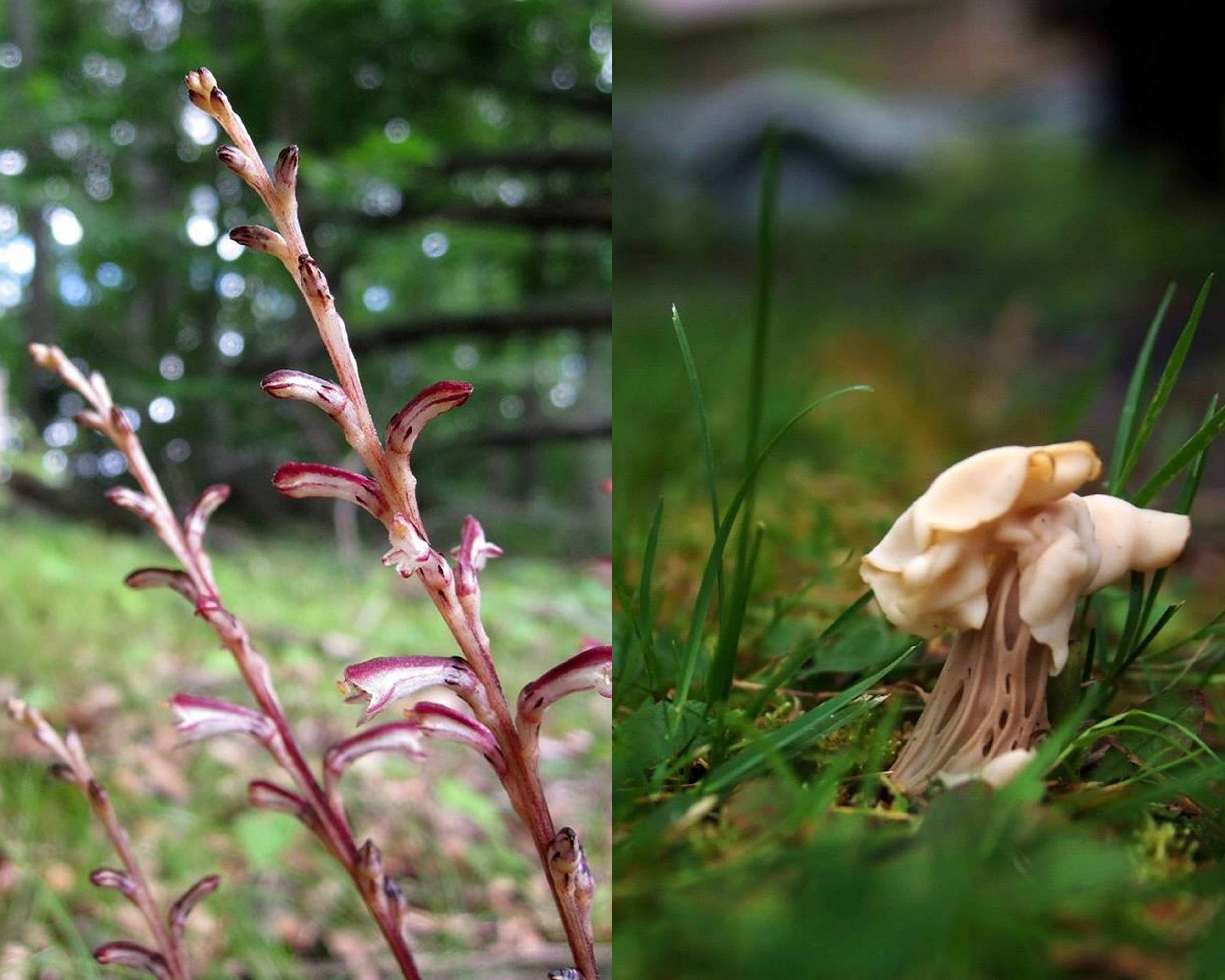
Let me help you out a bit! Left: beechdrops (by Dan Sparks-Jackson). Right: some mushroom I found (by Katie Grzesiak)
Many are very pale, and a little color goes a long way. For example, the purpley-red flowered beech drops have stems that are kind of booger-colored. Similarly, though the stems and leaves of clustered broomrape are not very colorful, its flowers are a lovely yellow.
Mycorrhizae are Communism
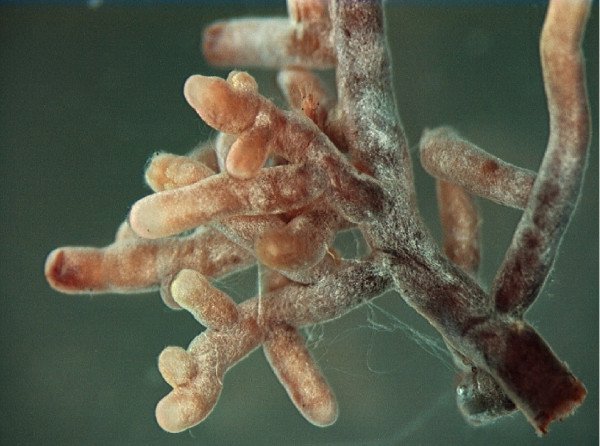
Mycorrhizal root tips look pretty weird. Photo: Wikipedia
Most fungi that we are familiar with (mushrooms, molds, etc.) “eat” dead stuff, like organic material in soil and things that have been in your fridge too long. Many plants, like birches, wheat, and roses, are in mycorrhizal (Greek again, for “fungus-root”) relationships: the plant gives the fungus sugars it makes (think bacon cheeseburgers), and in turn the fungus gives the plant nitrogen and minerals (think gummi vitamins) the fungus gets from the dead stuff it breaks down. Some plants and fungi just grow near each other and leak nutrients at each other, while other plants allow fungal hyphae (single-cell fungus strands) to grow into their roots between cells, or even inside their cell walls! Many mycorrhizal plants’ seeds can’t even sprout without their fungal friends nearby. Mycorrhizal relationships are like communism: some people farm, some people hunt, some people make clothes, everybody shares, and nothing bad ever happens.
Heteromycotrophs Steal from Communists
Some plants are too cool to just be friends with fungi for nitrogen. Plants called heteromycotrophs (MORE Greek! Hetero = different [e.g. food not from itself], myco = fungi, troph = feed) make friends with soil fungi, then steal all the food they need from the fungi. Often this fungi is already mycorrhizal with a different plant, making them extra juicy for the heteromycotroph to tap into. Heteromycotrophs are Keith, the guy at work who takes credit for other people’s output. If you’re a fungus, watch out for Keith.
Ghost plant (Monotropa uniflora, also called Indian pipe or corpse plant) is the heteromycotroph I see most often in northern lower Michigan. It’s in the same family as blueberries, but instead of forming happy shrubs with yummy berries, it sends up short (10-30 cm) thick white stalks with thin waxy leaves and drooping tubular flowers in late summer. Its fungal host is a mycorrhizal partner with trees, often beeches and pines. The craziest thing about ghost plant is its mysterious color range; they can be purely corpse-white, or (rarely) nearly blood red, or somewhere in between, and scientists are still trying to figure out why.
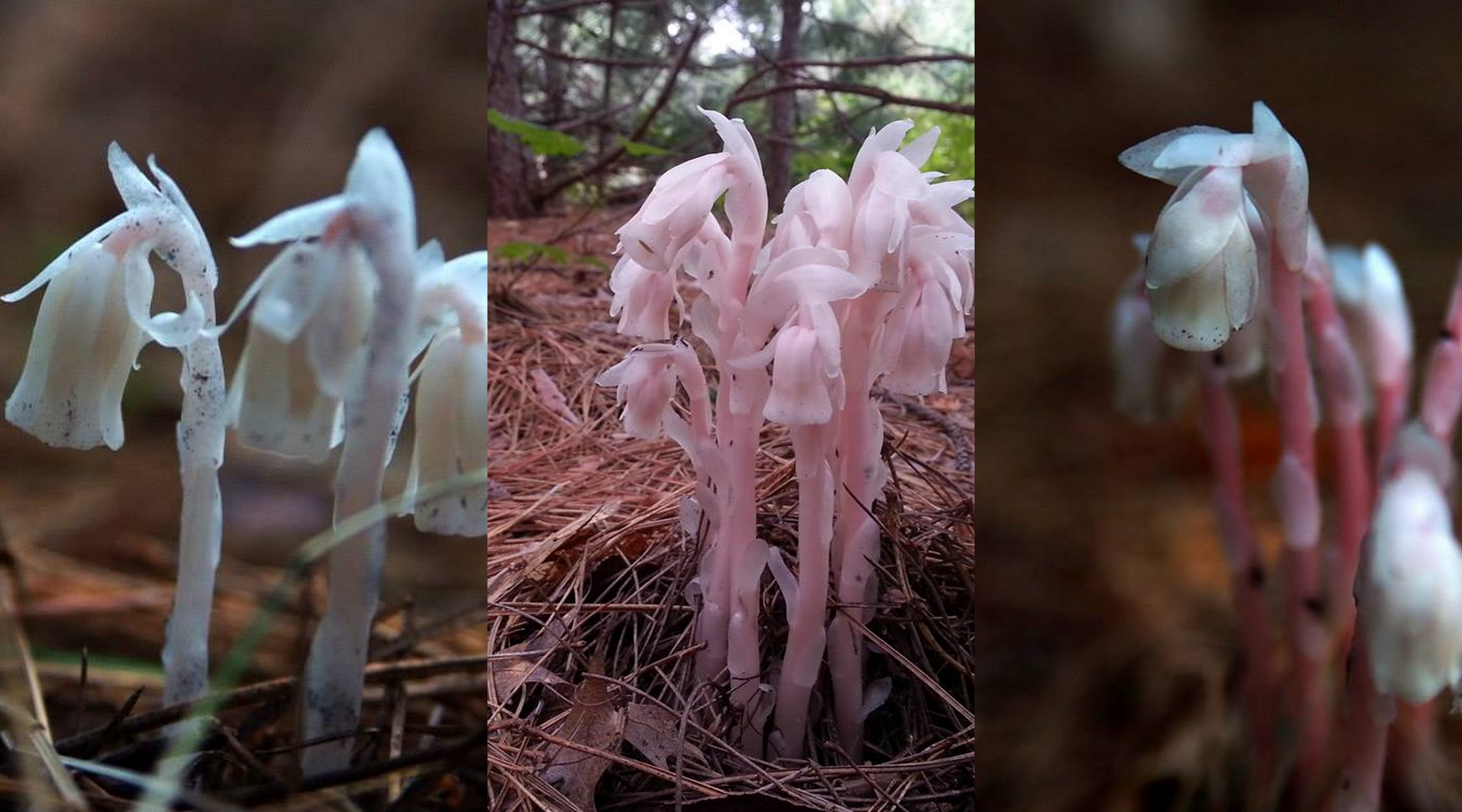
Color range of ghost plant. Fun fact: these photos were taken less than 10 minutes and 30 feet apart. Photos: Katie Grzesiak
Not all heteromycotrophs are virtually colorless. Most orchids have mycorrhizal associations at the very least, and quite a few are heteromycotrophs. My favorite is the striped coralroot orchid (Corallorhiza striata), which pops up with short (20-80 cm) stems of small striped flowers in early summer, and no green leaves ever. This tight association of plant to fungus makes many orchids impossible (so far) to artificially cultivate, though horticulturalists are still trying.
New Heteromycotroph!
On a plane ride to Spokane, WA to visit my brother, my seatmate and I got chatting; he asked if science was still discovering new plants. I consulted my Internet Machine and was able to answer YES! Though I’ve not heard of recent discoveries in temperate regions, a brand-new-to-science heteromycotroph, Gymnosiphon samoritoureanus, was discovered in Guinea in 2010. It’s tiny, with the tallest recorded sample only 5.2 cm tall, and has itsy-bitsy white flowers. Fun fact: though it is clearly related to others of its genus in Africa, it actually most closely resembles its relatives in the western hemisphere. What’s a couple hundred million years of separation and speciation between friends?
Conclusion: I Like Plants
You might have noticed. It is totally incredible how plants do photosynthesis–they use proteins containing the green pigment chlorophyll to harness the energy in light (mainly the blue and red wavelengths, in case you were curious), use that energy to scoot electrons around to create molecules, then use THOSE molecules to make sugars to store the energy long-term. But to have some species take your best-known trait and say “meh, the family business isn’t for me; I’m gonna branch (hah) out”? Whoa.
So here’s the important part: go find yourself some cool plants. Browsing Wikipedia is a great way to get excited, then take a walk. Plants without chlorophyll are found all over the world, if you look at the right time. Even if it’s not the right time, there are lots of plants quietly making their living. Some just do it in more devious ways than others, and that’s awesome.
References
Cheek, Martin, Xavier van der Burgt. “Gymnosiphon samoritoureanus (Burmanniaceae) a new speceis from Guinea, with new records of other achlorophyllous heteromycotrophs.” Kew Bulletin 65.1 (2010): 83-88. link
Freudenstein, John V. “A Monograph of Corallorhiza (Orchidaceae).” Harvard Papers in Botany 1.10 (1997): 5-51. link
Massicotte, HB, LH Melville, and RL Peterson. “Structural features of mycorrhizal associations in two species of the Monotropideae, Monotropa uniflora and Pterospora andromedea.” Mycorrhiza 15 (2005): 101-110. link
Nickrent, Daniel L, RJ Duff, AE Colwell, AD Wolfe, ND Young, KE Steiner, CW dePamphilis. “Molecular phylogenetic and evolutionary studies of parasitic plants.” Molecular Systematics of Plants II (1998): 211-241. link
Porras-Alfaro, Andrea, Paul Bayman. “Mycorrhizal fungi of Vanilla: diversity, specificity, and effects on seed germination and plant growth.” Mycologia 99.4 (2007): 510-525. link
Leelavathy, KM. “Effect of rhizosphere fungi on seed germination.” Plant and Soil 30.3 (1969): 473-476. link
Taylor, DL, CF Barrett, GE Beatty, SE Hopkins, AH Kennedy, MR Klooster. “Progress and prospects for the ecological genetics of mycoheterotrophs.” Mycoheterotrophy (2013): 245-266. link

